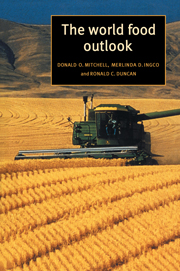Book contents
- Frontmatter
- Contents
- List of figures
- List of tables
- Preface
- List of abbreviations
- 1 The world food problem
- 2 The price of food
- 3 Gains in consumption levels
- 4 World food production increases
- 5 Population growth and food demand
- 6 The quantity and quality of the resource base
- 7 Raising yields
- 8 Changing consumption patterns
- 9 Simulating the future world food situation
- 10 The world can feed twice as many in twenty years
- 11 A robust prediction?
- 12 Africa presents a special challenge at the turn of the century
- Appendix The World Grains Model
- References
- Index
10 - The world can feed twice as many in twenty years
Published online by Cambridge University Press: 06 November 2009
- Frontmatter
- Contents
- List of figures
- List of tables
- Preface
- List of abbreviations
- 1 The world food problem
- 2 The price of food
- 3 Gains in consumption levels
- 4 World food production increases
- 5 Population growth and food demand
- 6 The quantity and quality of the resource base
- 7 Raising yields
- 8 Changing consumption patterns
- 9 Simulating the future world food situation
- 10 The world can feed twice as many in twenty years
- 11 A robust prediction?
- 12 Africa presents a special challenge at the turn of the century
- Appendix The World Grains Model
- References
- Index
Summary
The world can feed itself – this seems clear. The question is: at what price? Will we need to plough every hillside and dam every stream or have we ploughed and dammed enough? Will it become increasingly difficult to meet the world's demand for food or will it become increasingly easy?
The simulation results strongly suggest that the outlook for the world food situation is good, despite regional problems. Most consumers can expect to have increased food supplies and a greater variety of food at lower prices. The prices of staples such as grains will continue to decline relative to other consumer prices and incomes. These changes suggest further improvements in the diets of poor people, as has been the case over the past thirty years. Such gains will be possible because of higher crop yields and modest increases in cropland area. Major increases in resources devoted to crop production should not be required unless crop yields succumb to unforeseen problems.
The simulation results suggest only gradual increases in world grain consumption, production and trade. In the absence of a major shock, this is all that is required to continue the gains of recent years. The large increases in consumption are probably past for most consumers despite large differences in consumption levels. Consumers in the highest-income East Asian economies such as Japan, the Republic of Korea and Singapore consume only about one-half as much grain per capita as consumers in North America, but it does not appear that this gap will be reduced quickly.
Many consumers in developing economies increased consumption significantly during the 1960s and 1970s, but since then the increases have slowed.
- Type
- Chapter
- Information
- The World Food Outlook , pp. 120 - 147Publisher: Cambridge University PressPrint publication year: 1997



